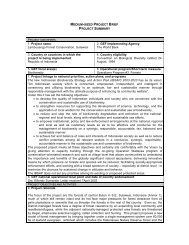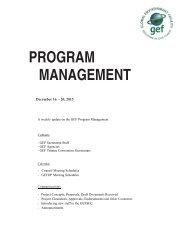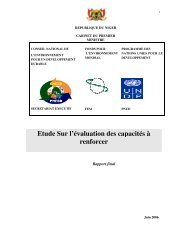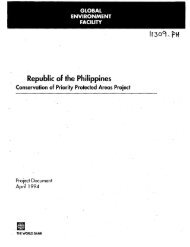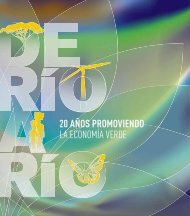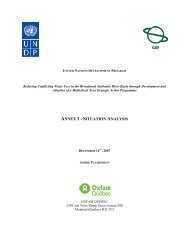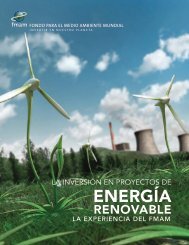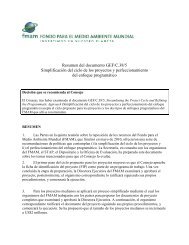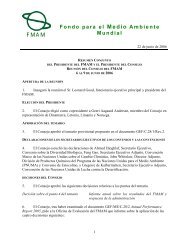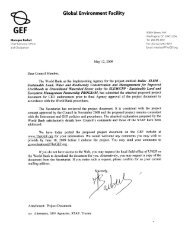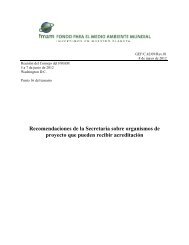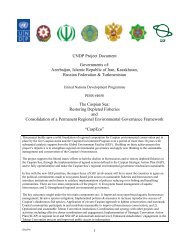English - Global Environment Facility
English - Global Environment Facility
English - Global Environment Facility
Create successful ePaper yourself
Turn your PDF publications into a flip-book with our unique Google optimized e-Paper software.
payments for environmental services) to support biodiversity conservation through collaborative<br />
agreements between public and private sector institutions.<br />
16. Component 2: Planning, operational management and monitoring of ecotourism in PAs.<br />
This component is aimed at enhancing planning and the quality of ecotourism products in<br />
selected PAs leading to an increase in quantitative and qualitative indicators of visitation, while<br />
at the same time improving capacities to monitor the effects of these products on the biodiversity<br />
of the PAs. The following activities will be financed: (i) conduct studies to define carrying<br />
capacity 7 , flow management and visitor monitoring for each of the 9 selected PAs. This will<br />
encompass the design and demonstration of visitor survey methodologies to collect key data on<br />
ecotourism use (e.g., visitor characteristics, expenditure patterns, willingness-to-pay) as a basis<br />
for setting fee structures that could be replicated to the entire SINAP. Once the survey<br />
instruments are designed, data will be collected in Year 1 to establish a baseline and each year<br />
subsequently; (ii) develop, approve and implement at least seven management and public use<br />
plans to identify and set objectives for ecotourism attractions, services and visitor use<br />
management in line with the each area´s conservation mandate and biodiversity values. This will<br />
entail analyses of the visitor baseline data collected in Year 1, the development of detailed public<br />
use zoning maps and norms, holding focus group sessions with key stakeholders (hotels, tour<br />
operators and guides, community representatives, research institutions), reaching consensus and<br />
approving the plans and promoting their dissemination. The plans will integrate adaptation<br />
strategies to respond to the impacts of climate change (e.g., coral bleaching, sea level rise,<br />
increase in storm surges, saltwater intrusion) in coastal, marine and terrestrial areas; (iii) identify<br />
a public investment portfolio for PAs jointly defined by ANAM and ATP, which will add value<br />
and attractiveness to ecotourism products (e.g., trails, observation towers, camping sites). Once<br />
defined and approved by the Bank, the portfolio will be financed by the Program; (iv) adaptation<br />
and expansion of the existing PMEMAP in the nine selected PAs to include cost-effective<br />
monitoring of biological and threat reduction indicators associated to the impacts of ecotourism<br />
on biodiversity (as designed in the ETIMS). The monitoring initiative will be undertaken in<br />
partnership with national universities and international research institutions with existing<br />
biological monitoring programs in Panama. It will also involve local businesses and communities<br />
with a presence in the PAs for the data collection activities after having received the appropriate<br />
training (see below); (v) training of PA on-site personnel to enhance their capacity to implement<br />
and enforce public use plans, maintain ecotourism facilities, work with local ecotourism service<br />
providers (i.e., guides) as well as to promote visitor appreciation and understanding of the<br />
biodiversity values of the PAs.<br />
17. Component 3: Strengthening of income generation potential for local stakeholders through<br />
ecotourism in selected PAs: This component encompasses the creation of conditions, which<br />
allow local key stakeholders in selected PA´s to obtain concrete economic benefits as a result of<br />
planned and organized management of biodiversity and sustainable use of natural and cultural<br />
resources within PA´s and their buffer zones. Activities to be financed include: (i) training of a<br />
minimum of 20 local organizations and operators in various aspects related to demand-driven,<br />
high-quality ecotourism services and products (e.g., integrating best practices, business<br />
management, certification and other types of environmental standards). The training and<br />
7 To support the definition of Public Use Plans, the project will either use carrying capacity-base or Limits of Acceptable<br />
Change (LAC) based methodologies.<br />
CEO Endorsement Template-December-08.doc 15



